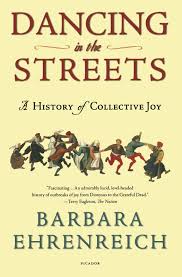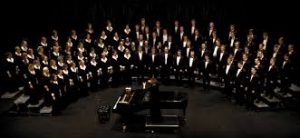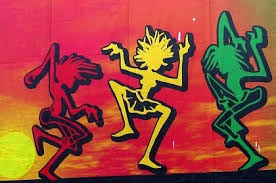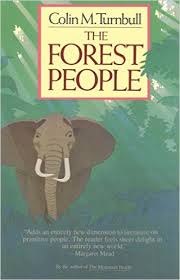Music, Community, and Culture Scholars:
Wonderful and brilliant class last Wednesday! Thank you all for working together towards forming a really fast connected community brain. That’s one of our goals and it’s working. To review our class session, we went through the basic tenents of this new, weird field called “Community Music.” Of course, community music has been going on for thousands of years. But, something happened as we moved from hunter-gatherer communities and into larger, more modern “societies.” Music-making and all kinds of other celebratory acts associated with “carnival” or “bacchinal.” In the West these pressure releasing societal celebrations (there are some vestiges around. . May Pole dances and such) were effectively stamped out by the 17th century. Here’s part of a summary of Barbara Ehrenreich’s, Dancing in The Streets: A history of collective joy:

For at least 10,000 years the human race has, at regular and officially sanctioned intervals, abandoned the hard diurnal grind of work and taken to the streets. Accompanied by drums and pipes, in masks and costumes, people, often hand in hand and usually in circles, sang and danced, faster and faster, until a climactic state of shared bliss was attained. Then, much invigorated, they returned to work and everyday life. This habit persisted until around the 13th and 14th centuries; it was finally stamped out, in the west, by the 17th. (retrieved from https://www.theguardian.com/books/2007/apr/07/society2, Jan. 28, 2017)
These “festivals,” for which there is ample historical and iconographic evidence, sported everything from speaking in tongues to drunkenness, and other “non-civilized” behaviours. Today, such activities are unseemly, but all was OK during that brief period (3 days perhaps in some cases). After that, people returned to their daily lives — working, raising families, going to church, building their communities. But, for the past 400 years we’ve been essentially without these “pressure valves” and a time when we live more densely together, when resources have been stretched, and societal stresses are very high. Ehrenreich posits that without these occasional releases societal balance is offset and society falls into states of breakdown and decay. The results over the past 100 years is rather obvious — Two massive world wars, hundreds of large continental conflicts, thousands of smaller wars, proliferation of isolationist and separatist thought systems, proliferation of physical violence, mental and physical stress, massive forced relocations, large population “kill offs”, and bewildering problems in articulating and attempting to enforce even the most basic of human rights. The United Nations Declaration of Human Rights (declared a milestone achievement) wasn’t released until 1984. Please visit it here. . .inspiring stuff. http://www.un.org/en/universal-declaration-human-rights/
 OK, that brings us directly to music. The musical vestiges of those big, carnival like outbursts where people danced, held giant parades, sang songs, danced, and revelled have been pushed off the streets and out of public spaces into controlled settings — schools, churches, auditoriums, concert halls (indoors for sure). Each of these venues has further shaped musical art forms into strictly-ordered, “civilized,” activities where the gathers themselves are scheduled (rehearsal times), individuals are vetted (auditioned), and sorted (placed by age groups and voice types). Church, school, and civic authorities further control these events and groups with policie
OK, that brings us directly to music. The musical vestiges of those big, carnival like outbursts where people danced, held giant parades, sang songs, danced, and revelled have been pushed off the streets and out of public spaces into controlled settings — schools, churches, auditoriums, concert halls (indoors for sure). Each of these venues has further shaped musical art forms into strictly-ordered, “civilized,” activities where the gathers themselves are scheduled (rehearsal times), individuals are vetted (auditioned), and sorted (placed by age groups and voice types). Church, school, and civic authorities further control these events and groups with policie s, etc. Since the 17th century, the structure of group musical organizations in the West have themselves surrendered to highly controlling cultural norms: The barline emerged in the 17th century (circular or modular musics disappear at this point — think isorhythmic motets, etc.) favouring primarily duple and triple, simplified rhythmic schemes (think about African rhythmic schemes vs. Western classical); large groups were controlled by authority figures modelled after celebrants (priests) in liturgy . . the model that gave rise to modern conductors; dancing and movement are effectively divorced from group music-making in the West (except for conductor, celebrant, or specialist); responsibilities for creativity and spontaneity so crucial in music-making, are first contained in sub-events (cadenzas) and eventually removed from groups of musicians altogether.
s, etc. Since the 17th century, the structure of group musical organizations in the West have themselves surrendered to highly controlling cultural norms: The barline emerged in the 17th century (circular or modular musics disappear at this point — think isorhythmic motets, etc.) favouring primarily duple and triple, simplified rhythmic schemes (think about African rhythmic schemes vs. Western classical); large groups were controlled by authority figures modelled after celebrants (priests) in liturgy . . the model that gave rise to modern conductors; dancing and movement are effectively divorced from group music-making in the West (except for conductor, celebrant, or specialist); responsibilities for creativity and spontaneity so crucial in music-making, are first contained in sub-events (cadenzas) and eventually removed from groups of musicians altogether.
 Big popular music movements like Rock, Jazz, Soul, Reggae and now community musics of all kinds are the backlash. We are trying to find that balance but the structures of civilization resist this pretty well. Note that all these forms reintegrate music and movement with drumming and percussive forms, things that were marginalized in Western music since the 17th century in favour of the development of modern harmonies. So, at this point we have a lot of music going on, all kinds, and more people than ever involved in consuming it. . . that’s the rub. . since the 1950s and the advent of accessible recordings music became less of an activity between people and more of a product, a noun, a consumable.
Big popular music movements like Rock, Jazz, Soul, Reggae and now community musics of all kinds are the backlash. We are trying to find that balance but the structures of civilization resist this pretty well. Note that all these forms reintegrate music and movement with drumming and percussive forms, things that were marginalized in Western music since the 17th century in favour of the development of modern harmonies. So, at this point we have a lot of music going on, all kinds, and more people than ever involved in consuming it. . . that’s the rub. . since the 1950s and the advent of accessible recordings music became less of an activity between people and more of a product, a noun, a consumable.

Community Music seeks to break down the separations created by the cultural situations of the last several hundred years. OUCH, right? Perhaps really, it just seeks to reestablish connections between human beings, something that music is uniquely equipped to accomplish. But, what about all this talk of healing communities, and developing stuff like social capital and power? That deep discussion is for another class and another post. But, for now I leave you with this. We can look to other cultural forms of music making to inform and reform our own:

Renowned anthropologist, Colin Turnbull (OMG another “Colin”) in his work The Forest People (1961) studied the practice of singing songs and dancing amoung the Mbuti people of the Congo. He found that they sang for healing. When there was sickness or sadness, they felt that something was amiss with the forest itself. They considered themselves part of the forest and so the sickness would be manifest in their own bodies and minds. The Mbuti sang and danced “molimo songs” literally to heal the forest. That is, to bring balance back to their entire environment. Could it be that Community Music and Music Therapy are responses to our own societal/environmental/relational imbalances? Could it be that our need to do play music together, to sing, to express, to dance, to create, to play, to find joy in community is in fact, a basic survival instinct developed over the 10,000 years where we created music together?
OK, here’s the presentation from class lecture.
Bringing Culture to Music – Created with Haiku Deck, presentation software that inspires;
We have yet to discuss power. . . .I welcome and encourage your comments on these ideas. (Oh, you won’t find them anywhere on the internet on some wiki page. . that’s right. . I put it together myself with the help of about 40 different sources. . . Here’s to the practice of reading, listening, music making, and research!) Looking forward to hearing from you.
Dr. Yun
I find it interesting how some people in today’s society only consider Classical music to be “authentic” music, and completely hate on the less-structured, more “rowdy” stuff. But at the same time, there are others that see music which is created from the heart and spontaneously to be real, and say Classical music is too “uptight”. What do these contrasting views say about music as a whole, as well as the purposes it has served throughout history? To put it into context, how the divide between social classes affected what kind of music was created.
(I hope that made sense – I have all these ideas in my head but don’t exactly know how to put them into words.)
Great insights! The word “authentic” is very confusing and we will get into more deeply in class since you’ve so nicely brought it into our circle. Perfect timing. Authenticity is not an objective truth. Instead, it is a statement of relationship. We are authentic or I am authentic in relation to something else — culture, relations, my self, values, etc. So, authenticity depends on identity. And our identity is contained and brought out by our locating exercises. So, classical music is indeed authentic in relationship from its own culture of which many of us are a part; we have been raised in it, right? But, it is not the only thing with which we identify. Our identity and therefore our “authenticity” extends beyond classical music. So for some people who fully identify with classical music, it is completely authentic. For the rest of us, not so much. Does this make sense? For most of us, there are multiple musics that are authentic to us. Why do identify with certain musics? What does this say about our practices as community musicians or therapists?
While I see the value of stress-relieving festivals involving music and dance and general carousing, I am extremely skeptical of the correlation you’ve drawn between the apparent lack of festivals and terrible world events. Off the top of my head, I can think of the conquests of Alexander the Great, the fall of Rome, the Dark Ages, the Crusades, and the genocides associated with the colonization of the American continents, all of which occurred or originated previous to the 17th century. Don’t we need stronger, less alarmist arguments?
And I think we may be closer to those original festivals than the stuffy concert hall. I’m thinking outdoor festivals like Field Trip, NXNE, Bluesfest, and Way Home. I grant you that they are expensive, and the dichotomy of performer/audience still exists, but it is a sanctioned form of stress-relieving carousing. Is there room to expand the limits of the festivals to include community music making?